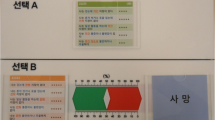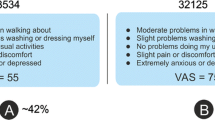Abstract
The feasibility, validity and reliability of the Time Trade-Off (TTO) and Visual Analogue Scale (VAS) methods in obtaining preference values for health states were compared in a random sample of the Spanish population (n = 294). Respondents valued 43 EuroQol-5D health states in face-to-face interviews. Convergent validity was assessed by examining the relationship between values, and the effect of sociodemographic and health variables on values was used as a means of assessing construct validity. Test–retest reliability was analysed in a sub-group of 50 respondents, using the intraclass correlation coefficient (ICC) and generalisability theory. Rates of non-response and missing data were low on both methods, though the VAS took considerably less time to administer. VAS and TTO values correlated highly (r = 0.92), though there were differences in the ordering of health states between methods, and in the number of health states rated worse than death. VAS values were compressed into a considerably smaller valuation space than TTO values. Respondents in higher educational categories assigned higher TTO values to 12 health states. Mean ICCs (95 CI) at individual level were 0.90 (0.88–0.92) and 0.84 (0.81–0.87) for the VAS and TTO, respectively. Generalisability analysis showed variance due to time to be 0 for both methods. In conclusion, the VAS was more feasible and slightly more reliable than the TTO, whilst doubt can be cast on the degree of convergent validity existing between the two methods. The compression of VAS values means that the TTO is likely to discriminate better between health states, and it may have greater construct validity if results from larger samples confirm that there are genuine differences between sociodemographic sub-groups.
Similar content being viewed by others
References
Richardson J. Cost utility analysis: what should be measured? Soc Sci Med 1994; 1: 7–21.
Badia X, Rovira J. Evaluación económica de medica-mentos: un instrumento para la toma de decisión en la práctica clínica y la planificación sanitaria. Madrid: Luzán 5, S.A. de Ediciones, 1994.
Williams A. Economics of coronary artery bypass grafting. Br Med J 1985; 291: 326–329.
Kaplan RM, Feeny D, Revicki DA. Methods for as-sessing relative importance in preference based out-come measures. Qual Life Res 1993; 6: 467–475.
Torrance GW. Measurement of health state utilities for economic appraisal. Health Economics 1986; 5: 1–30.
Froberg DG, Kane RL. Methodology for measuring health-state preferences-II: scaling methods. J Clin Epidemiol 1989; 42: 459–471.
Bass EB, Steinberg EP, Pitt HA, Griffiths RI, Lillemoe KD, Saba GP, Johns C. Comparison of the rating scale and the standard gamble in measuring patient prefer-ences for outcomes of gallstone disease. Med Decis Making 1994; 4: 307–314.
Revicki DA, Kaplan RM. Relationship between psy-chometric and utility-based approaches to the mea-surement of health-related quality of life. Qual Life Res 1993; 6: 477–487.
Read JL, Quinn RJ, Berwick DM, Fineberg HV, Weinstein MC. Preferences for health outcomes: com-parisons of assessment methods. Med Decis Making 1984; 4: 315–329.
Torrance GW. Social preferences for health states: an empirical evaluation of three measurement techniques. Socio-Econ Plan Sci 1976; 10: 129–136.
Stiggelbout AM, Eijkemans MJC, Kiebert J, Leer JW, de Haes JC. Utility. The ‘utility’ of the visual analogue scale in medical decision making and technology as-sessment. Int J Technol Assess Health Care 1996; 2: 291–298.
Neumann J von, Morgenstern O. Theory of games and economic behaviour. New York: Wiley, 1944.
Schoemaker PJ. The expected utility model: its vari-ants, purposes, evidence and limitations. J Econ Lit 1982; 20: 529–563.
Sutherland HU, Llewellyn-Thomas H, Boyd NF, Till JE. Attitudes toward quality of survival. The concept of “maximum endurable time”. Med Decis Making 1982; 2: 299–309.
Brooks R, EuroQol Group. EuroQol: the currrent state of play. Health Policy 1996; 37: 53–72.
Dolan P, Gudex C, Kind P, Williams A. The mea-surement and valuation of health. First report on the main survey. The MVH Group, University of York, 1995.
Dolan P, Gudex C, Kind P, Williams A. Valuing health states: A comparison of methods. J Health Econ 1996; 15: 209–231.
Dolan P, Gudex C, Kind P, Williams A. The time trade-o. method: results from a general population study. Health Econ 1996; 5: 141–154.
Ohinmaa A, Helala E, Sintonen H. Modelling EuroQol values of Finnish adult population. In: Badia X, Herdman M, Segura A, eds, EuroQol Plenary Meeting: Discussion Papers, Barcelona, 3–6 September 1995: 67–76.
Badia X, Schiaffino A, Alonso J, Herdman M. Using the EQ-5D in the Catalan general population: feasibility and construct validity. Qual Life Res 1998; 7: 311–322.
Nord E. Methods for quality adjustment of life years. Soc Sci Med 1992; 5: 559–569.
Gudex C, Dolan P, Kind P, Williams A. Health state valuations from the general public using the visual analogue scale. Qual Life Res 1996; 5: 521–531.
Van Agt H, Essink-Bot ML, Krabbe P, Bonsel G. Test-retest reliability of health state valuations collected with the EuroQol questionnaire. Soc Sci Med 1994; 11: 1537–1544.
Krabbe P, Essink-Bot ML, Bonsel G. The compara-bility and reliability of five conventional health-state valuation methods. Soc Sci Med 1997; 11: 1641–1652.
Martinez R. Psicometría: Teoría de los test psicológicos y educativos. Madrid: Síntesis psicológica, 1995.
Dolan, P, Kind, P. Inconsistency and health state val-uations. Soc Sci Med 1996; 42: 609–615.
Sutherland HJ, Dunn V, Boyd NF. Measurement of values for states of health with linear analog scales. Med Decis Making 1983; 4: 477–487.
Nord E. The validity of a visual analogue scale in de-termining social utility weights for health states. Int J Hlth Plan Man 1991; 6: 234–242.
Bleichrodt H, Johannesson M. An experimental test of the theoretical foundation for rating-scale valuations. Med Decis Making 1997; 2: 208–216.
Robinson A, Dolan P, Williams A. Valuing health status using VAS and TTO: what lies behind the numbers? Soc Sci Med 1997; 8: 1289–1297.
Badia X, Herdman M, Kind P. The influence of ill-health experience on the valuation of health. Pharmaco Economics 1998; 6: 687–696.
Dolan P. The effect of experience of illness on health state valuations. J Clin Epidemiol 1996; 49: 551–564.
Author information
Authors and Affiliations
Rights and permissions
About this article
Cite this article
Badia, X., Monserrat, S., Roset, M. et al. Feasibility, validity and test–retest reliability of scaling methods for health states: The visual analogue scale and the time trade-off. Qual Life Res 8, 303–310 (1999). https://doi.org/10.1023/A:1008952423122
Issue Date:
DOI: https://doi.org/10.1023/A:1008952423122




